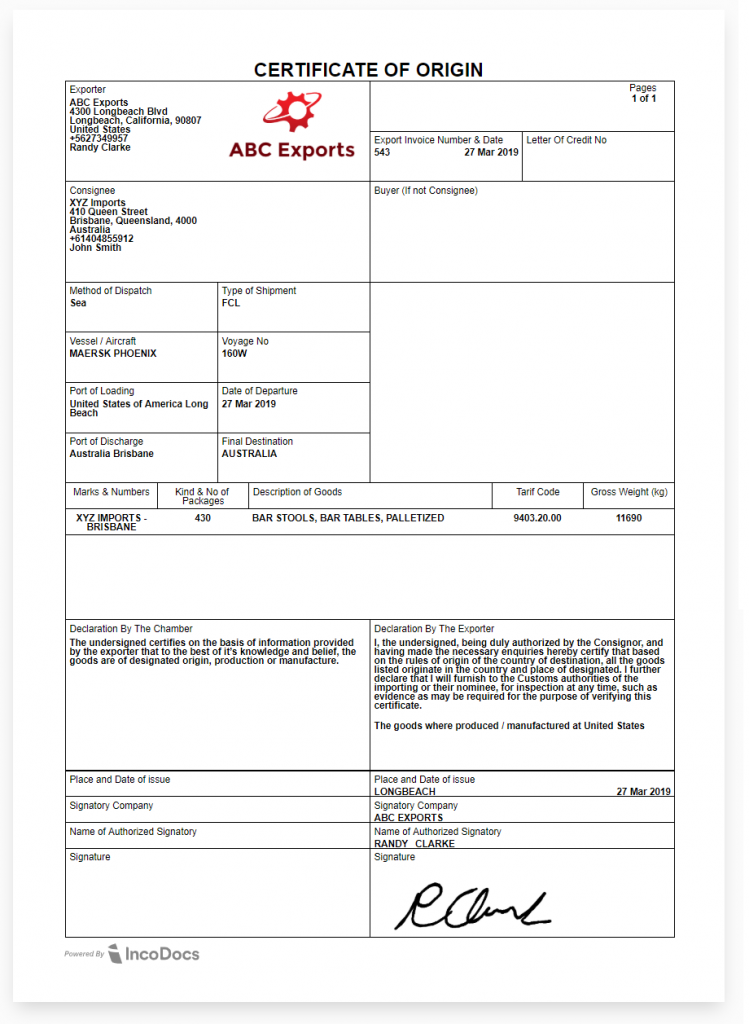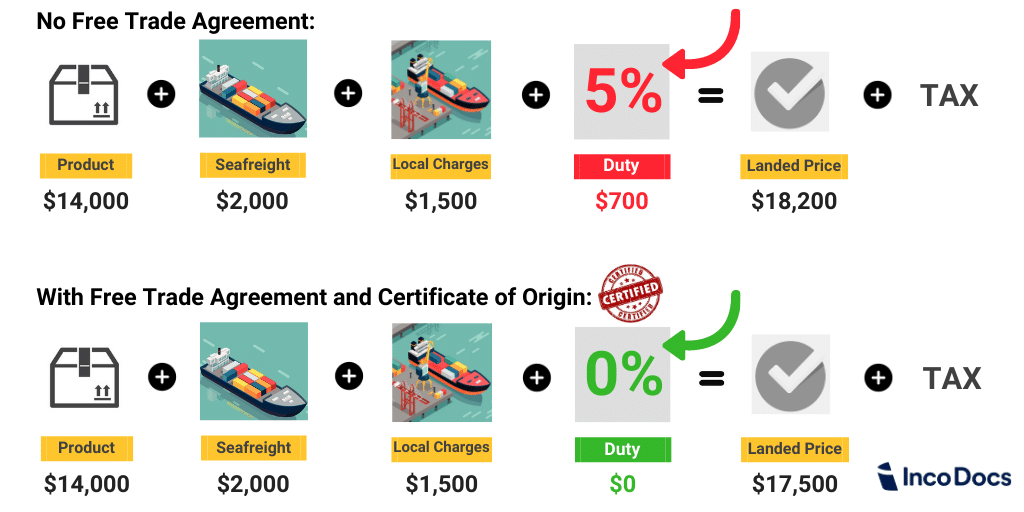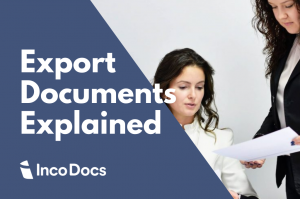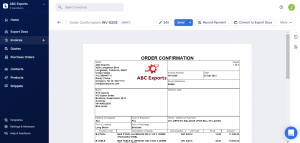Chambers of Commerce play a pivotal role in issuing Certificate of Origin documents used for global trade.
A certificate of origin document is an important document used in global trade to confirm the country of origin of where the goods have been manufactured or processed. The document is used when the country of export and the country of import have a current Free Trade Agreement (FTA) in place (see bottom of article). These FTAs include specific rules of origin that determine the eligibility of goods for reduced or eliminated import duties and tariffs in the country of import. Chambers of Commerce will authorize Certificates of Origin (COs) documents used in international trade.
How a Certificate of Origin works in the import-export process
The certificate of origin document will be used by the importer’s freight forwarder, customs agent or customs broker during the import customs clearance process. These brokers will use the certificate to prove to customs that the goods have been manufactured within the country of export. As a result, this will reduce or eliminate the import duties that are payable on imported goods.
Which party provides the Certificate of Origin?
The shipper can create their own Declaration of Origin template to make a declaration on behalf of their company. This document will state the country where the goods originated (usually the country of export). It indicates whether the goods qualify for preferential treatment under a Free Trade Agreement. However, most import countries customs departments will require that the certified document from the local Chamber of Commerce in the country of export. That local Chamber of Commerce will act as the 3rd party that will verify the shipper’s declaration. They charge a fee to sign and stamp the document. This document will then become ‘certified’ and the shipper will email it, along with the corresponding invoice and Bill of Lading, to the importer so that it can be used in the customs clearance process. The shipper must provide the document before the shipment arrives into the country of import to avoid any problems or delays with the customs clearance process.
How to obtain a Certificate of Origin from a Chamber of Commerce
Each country have their own set Chambers of Commerce that will specialize in certificate of origin documents. For example, if you’ve shipped products from the USA to Canada then you can contact any local or state American Chamber of Commerce (AmCham) and submit your NAFTA certificate (now renegotiated as the USMCA) or declaration of origin template. Most Chambers still manually sign and stamp original documents, whilst other chambers may offer an online digital certificate of origin solution.
Note that there is no official governing authority overseeing all chambers and their processes can vary. It is crucial to verify that your local chamber is accredited by the International Chamber of Commerce (ICC) and adheres to ICC guidelines for electronic certificates of origin (eCOs) and certificates of origin. Ensuring your chamber follows these standards is essential for smooth customs clearance, as proper documentation validates the origin of goods and helps prevent delays.
Popular Chambers of Commerce around the world:
- American Chamber of Commerce
- British Chamber of Commerce
- Hispanic Chamber of Commerce
- Indian Chamber of Commerce
- Canadian Chamber of Commerce
What information is included on the Certificate of Origin template?
A Declaration Of Origin or Certificate of Origin form will include the below details:
- Shipper’s (Exporter’s) company name, address and contact details
- Consignee’s company name, address and contact details
- Port of loading
- Port of discharge
- Vessel Name and Voyage Number
- Date of Departure
- Final Destination
- Certificate Number
- Exporter’s Reference
- Letter of Credit (if required)
- 3rd party details (if required)
- Details of products included in the shipment – including shipping marks and numbers, number and kind of packages, description of goods, HS Code / Tariff Code, Gross Weight
- Statement of the country of origin of goods
- Name, date and signature of the authorized company representative
 Certificate of Origin template example
Certificate of Origin template exampleWhat is Free Trade Agreements?
Free Trade Agreements (FTAs) are international treaties that reduce barriers for trade and investment. They are individual agreements between two countries that act to reduce or eliminate the import tariffs (import duty fees) that are paid on imported goods. The origin of goods, as indicated on the Certificate of Origin, is used to determine eligibility for these reduced tariffs. So, these import tariffs are charges that are payable when the country of destination imported products. When the country of import and export have a current Free Trade Agreement in place it will reduce or eliminate the import duty fees payable.
Why do Free Trade Agreements Exist?
Free Trade Agreements exist primarily to increase two-way trade between the countries. They benefit both nations involved as it encourages importers to source and purchase products from exporters in the other. Some of the Importers’ costs are reduced which makes the exporter’s products more competitive and appealing to buyers in the other country. In addition, they also help with overcoming some internal barriers which impede the trade of goods and services between countries. They also encourage increased investment and cooperation in international trade.
Here is a list of Countries with bilateral Free-Trade agreements
An example of how the Certificate of Origin reduces import duties
The below example explains how using a Certificate of Origin in international trade can reduce or eliminate the import duties.
- The importer shipped $14,000 of products
- The importer must pay all associated import costs, including sea freight charges, local port handling/customs charges, import duties & taxes.
- If the country of export and country of the import do not have a current Free Trade Agreement, then the importer will have to pay import duties on these goods (in this example, 5% of the product value).
- However, if the 2 countries do have a Free Trade Agreement in place AND the exporter provides a Certificate of Origin, the importer’s fees will be reduced or eliminated (Duty-Free, 0%).

What is the difference between Preferential and Non-Preferential Certificates of Origin (COs)?
The difference between Preferential and Non-Preferential Certificates of Origin (COs) lies in their purpose and benefits. A Preferential CO is used when goods qualify for reduced tariffs or exemptions under a Free Trade Agreement (FTA) between countries. This type of certificate helps importers save on duty fees, making the goods more competitive in the destination market. It is crucial for importers and exporters who want to take advantage of these trade agreements.
On the other hand, a Non-Preferential CO does not grant any special tariff benefits. It simply certifies the country where the goods were manufactured or processed. This type of certificate is used for general trade purposes and is required for goods that do not qualify for preferential treatment. Both types of COs are essential for international trade but serve different roles in the customs process.
How Certificates of Origin Influence Landed Cost
Landed cost is the total cost of getting goods to their final destination. The calculation includes the cost of the goods, shipping, handling, duties, taxes, and any other fees. Knowing the landed cost is crucial for businesses. It helps them understand the full expenses involved in importing goods.
A Certificate of Origin can directly affect the landed cost via helping to determine the duties and taxes that must be paid. If goods qualify for preferential treatment under a Free Trade Agreement, the duties may be reduced or eliminated. This can significantly lower the landed cost, making the goods more competitive in the market. Accurate documentation ensures that all costs are correctly calculated and no unexpected expenses arise.







